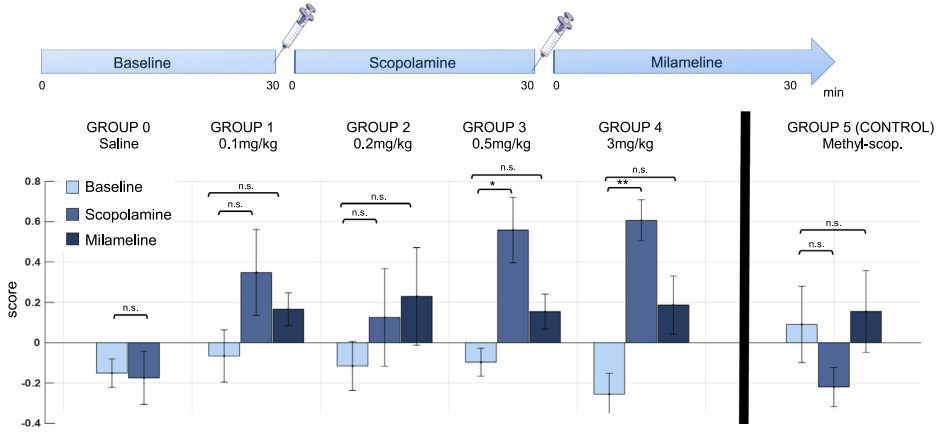
Pharmaco-fUS: How Ultrasound could foster drug discovery in neuroscience
Developing therapeutic drugs for brain disorders requires to assess their effects on brain functions. Neurofunctional ultrasound (fUS) imaging offers numerous advantages for investigating and monitoring drug effects in the brain in a robust, specific and sensitive manner by recording the whole-brain hemodynamics in awake animals at high spatiotemporal resolution. The technology is already available for preclinical research and is becoming an invaluable tool for drug evaluation, as evidenced by three recent independent publications (one from our group and two from another French consortium) and a poster award at the virtual European Molecular Imaging Meeting.
Our group has pioneered neurofunctional ultrasound (fUS), an imaging modality capable of mapping the brain activity at a very high sensitivity and high spatiotemporal resolution. Amongst several preclinical applications, therapeutic drug development could greatly benefit from the capabilities of fUS imaging. fUS imaging allows to study dynamic brain activation patterns across large fields-of-view, in awake (unanesthetized) animals. Three different studies have recently demonstrated that fUS can be used to quantify the effect of pharmaceutical drugs on brain functions, by assessing the variations of cerebral blood volume and functional connectivity as a function of the dose administered.

In the first study, conducted by our group Physics for Medicine Paris, in collaboration with the Institute of Psychiatry and Neurosciences of Paris and Iconeus, adverse Alzheimer’s disease-like effects were induced by administering various doses of scopolamine, and then reversed using milameline as a recovery treatment. The subsequent changes in functional connectivity were monitored as a function of time and dose, resulting in the definition of a score that could be used to quantify the effects of Alzheimer’s disease treatments. This work was also presented by our former PhD student Claire Rabut at the virtual European Molecular Imaging Meeting, held in August 2020, and was selected in the Best Of Poster-Pitches in the category “Neuro- and Cardiovascular Imaging”.
The second study, led by the pharmaceutical company Theranexus, focuses on another treatment of Alzheimer’s disease and compares the hemodynamic response of the brain to the administration of donepezil alone (already marketed treatment) versus donepezil combined with mefloquine (treatment under development). The results confirmed the potential of the combined treatment and provided new insights on how both drugs could interact. In the third study, Theranexus investigated the effect of atomoxetine, a drug used in the treatment of attention-deficit/hyperactivity-disorder. Dose-dependent variations of the cerebral blood flow was observed particularly in brain areas involved in vision.
These three studies demonstrate that pharmaco-fUS is a new powerful tool to obtain robust read-outs for drug evaluation, and investigate the drugs mechanisms of action. Pharmaco-fUS does not require the animals to be anesthetized, and therefore yields a quantitative assessment of brain functions with no anesthesia-induced biases. Pharmaco-fUS currently acquires cross-sectional (2D) views of the rodent brain. We expect that the potential of pharmaco-fUS will be even greater with the development of volumetric (3D) imaging, which will enable drug effect assessment across the whole rodent brain within a single imaging session.
Links to full-text publications:
- Rabut C, Ferrier J, Bertolo A, Osmanski B, Mousset X, Pezet S, et al. Pharmaco-fUS: Quantification of pharmacologically-induced dynamic changes in brain perfusion and connectivity by functional ultrasound imaging in awake mice. NeuroImage 2020 doi:10.1016/j.neuroimage.2020.117231
- Vidal B, Droguerre M, Valdebenito M, Zimmer L, Hamon M, Mouthon F, Charvériat M. Pharmaco-fUS for Characterizing Drugs for Alzheimer’s Disease – The Case of THN201, a Drug Combination of Donepezil Plus Mefloquine. Frontiers in Neuroscience 2020 doi:10.3389/fnins.2020.00835
- Vidal B, Droguerre M, Venet L, Zimmer L, Valdebenito M, Mouthon F, Charvériat M. Functional ultrasound imaging to study brain dynamics: Application of pharmaco-fUS to atomoxetine. Neuropharmacology 2020 doi:10.1016/j.neuropharm.2020.108273

In 2016, researchers of our group founded the spinoff company Iconeus, which leverages neurofunctional ultrasound in the field of preclinical and clinical neuroimaging. Iconeus commercializes the first ultrasonic neuroimaging scanner with already a large community of early-adopters both in industry and academics.




